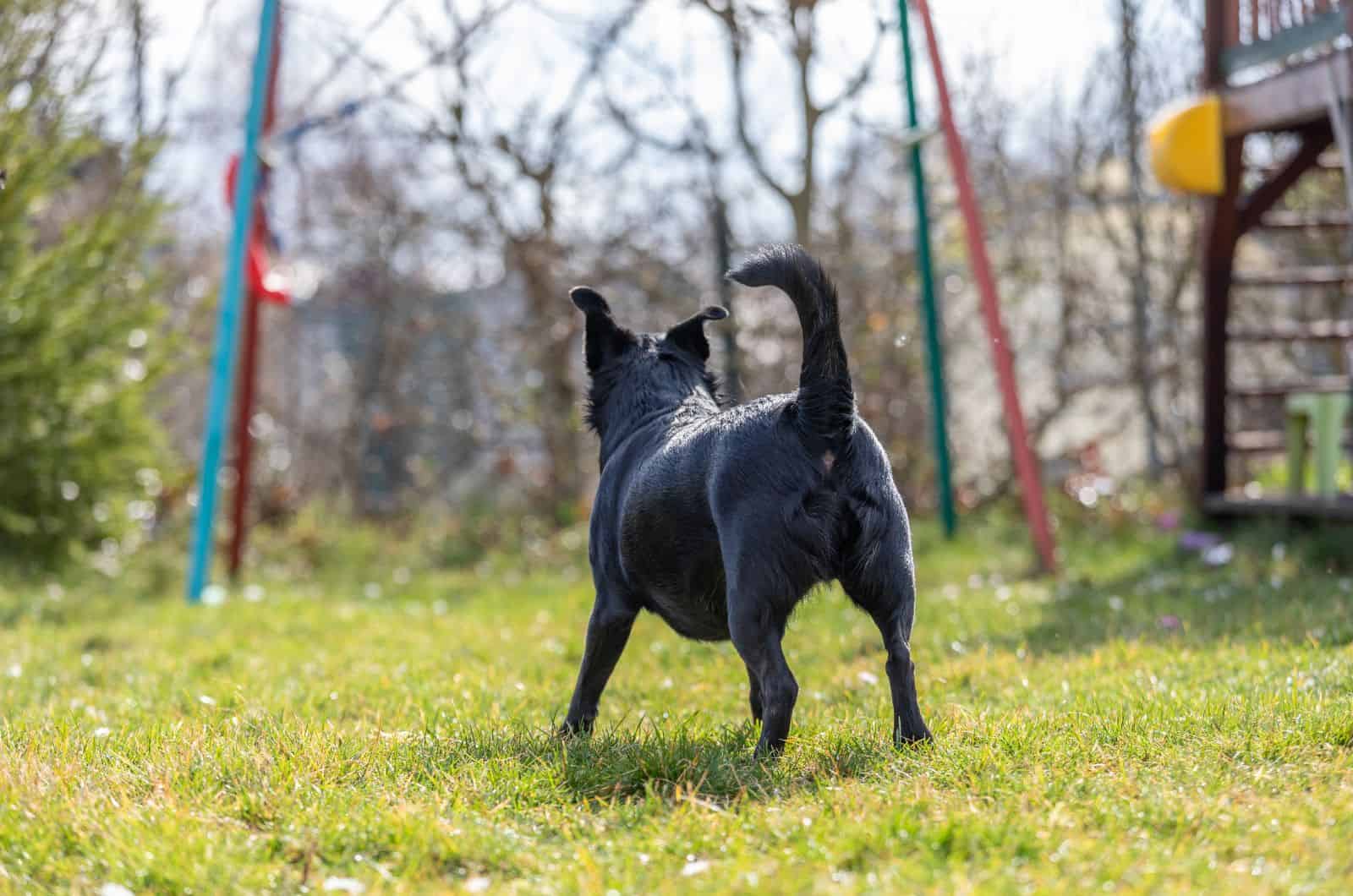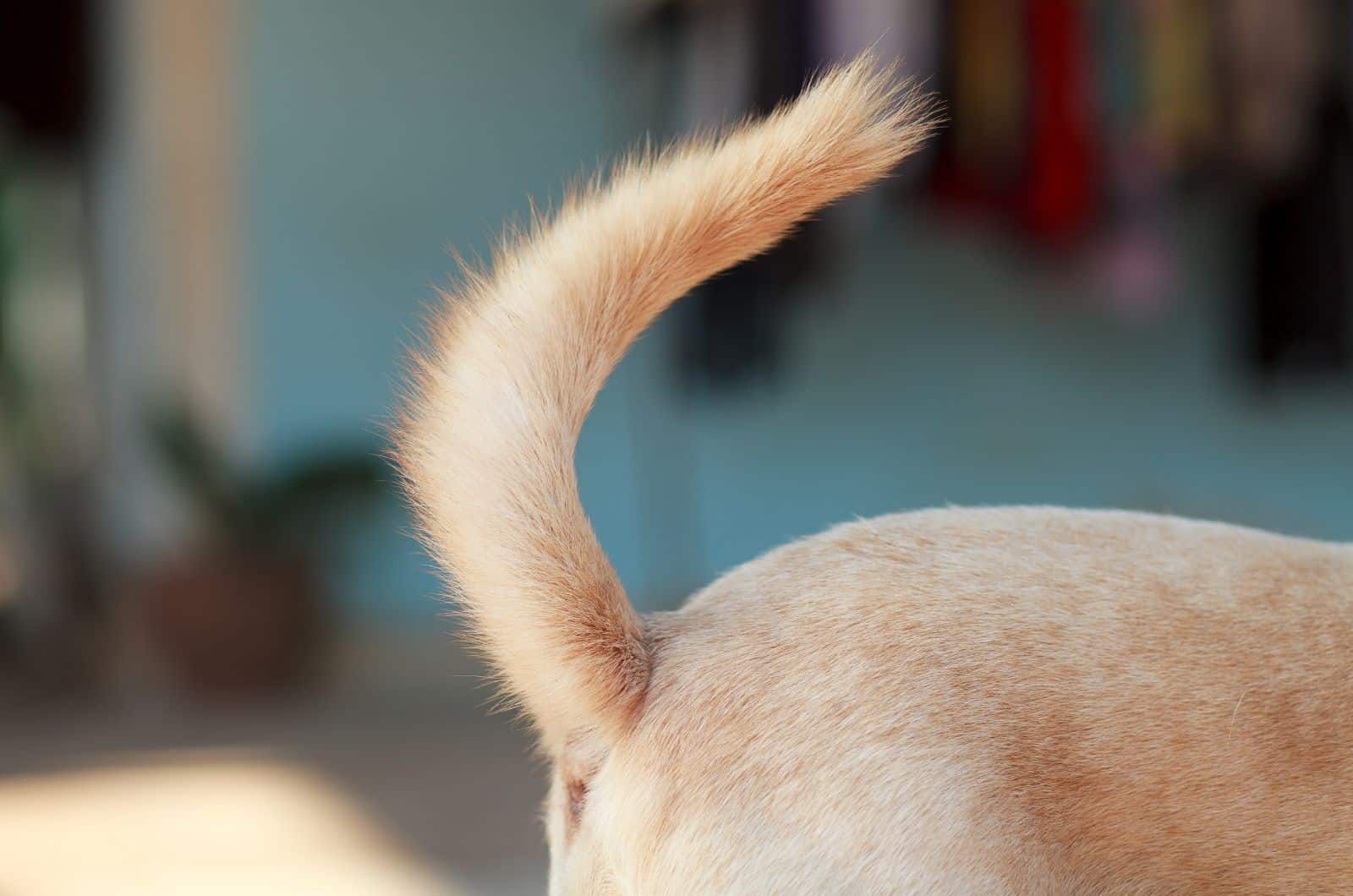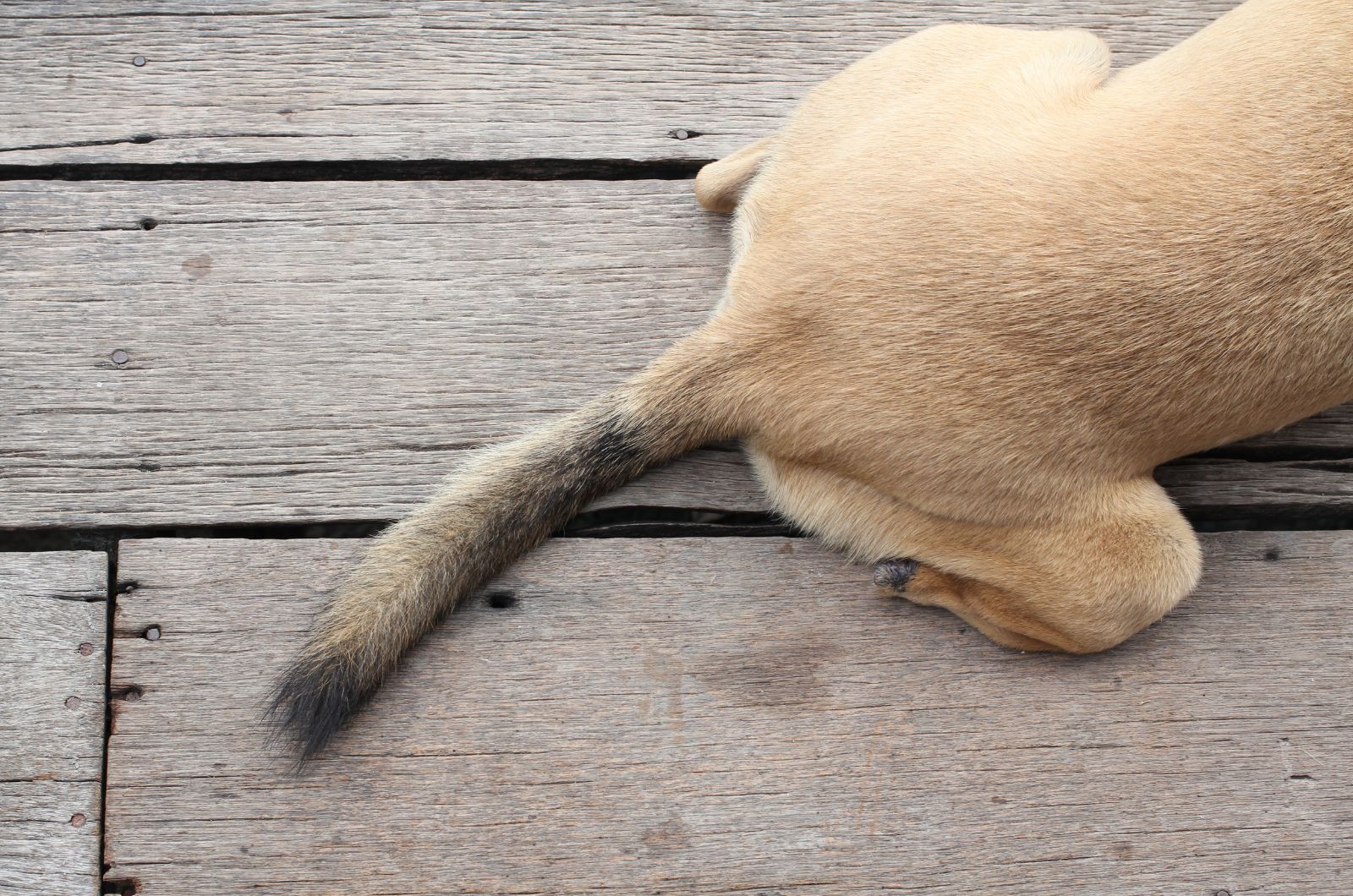When one hears the words “happy tail”, they don’t immediately associate it with anything bad, but happy tail syndrome is definitely not a positive thing.
The happy tail syndrome in dogs is translation for a tail injury that happens from your dear doggo wagging his tail a bit too hard and having it end up smacking into something hard.
It may sound incredibly unbelievable, but it does happen as a wagging tail can be swung hard enough that having it whack against a hard surface leads to an injury of varying degrees.
The most common injuries are cracks on the tip of the tail or blood splatters after the fact, with some even ending up with a broken end of the tail in some more severe tail injuries.
The worst case, however, is if your dog can’t control his tail during the healing process which may lead to frequent re-injury and the inability for it to recover, which is where the doctor may decide for an amputation.
Keep in mind, this is only the last resort scenario, and treatment of happy tail syndrome has advanced considerably over the years, so the amputation option rarely ever comes into play.
To find out more about happy tail syndrome, why it happens and how to prevent it as well as treat it should the need arise, read on to find out more.
What Is Happy Tail Syndrome?

Well, the earlier description may have given most of it away, but happy tail syndrome occurs when a dog simply wags his tail a bit too hard and ends up striking it against a surface to the point where it causes damage.
Now, not every tail is prone to doing this. Long tails are more suspect to this as they have a wider swing arc and thus generate more velocity, which increases the likelihood of damage.
Tails that are thinner are more prone to this too, as are tails that are only covered in thin skin rather than fur or simply some thicker skin though this is mostly breed dependent.
Finally, the tail contains a lot of blood vessels which, when paired up with the other risk factors, can create quite the gory scene when everything bad lines up and a powerful enough strike causes them to pop, leading to this issue.
The surface itself isn’t just any hard surface, it’s usually the ones with sharper corners which concentrate the impact power to one specific point that ruptures and potentially even breaks, causing your pooch a great deal of pain and discomfort.
Thankfully, if the problem is prevented early or the impact wasn’t all that strong, it can be solved by quickly applying first aid on the spot and patching the tail up so it doesn’t move around too much.
Your furry friend may whine for a bit, but, ultimately, everything should be a-ok, however, it should still be looked over by a vet if you suspect some lingering damage may have been sustained to the vertebrae of the tail.
Which Dog Breeds Are Most Prone To The Happy Tail Issue?
While every dog breed can end up with a happy tail given enough force, the most common occurrences of the syndrome end up happening to large dog breeds with skinnier tails.
The most common dog breeds this happens to are:
- Various shepherd dogs
- Greyhounds
- Great Danes
- Pit Bulls
- Dobermans
- Great Danes
- Labrador Retrievers
Smaller dog breeds are less likely to suffer from this, but the general rule is that if a dog wags his tail hard enough or hits it against a sharp enough surface, he can get a happy tail, so you should always be wary regardless of your pet choice.
How To Treat Happy Tail Injuries?

While the earlier descriptions may have sold happy tail syndrome as a serious injury, most often it’s just a temporary one that will go away through proper treatment.
Here’s how to handle one, step-by-step.
1. Finding Out The Level Of Tail Damage
The first thing that you should do in any situation revolving around a pet injury is to look over the injured area and assess the severity of the injury.
Panicking just because you see some blood won’t do you or your pet any good as his own anxiety is likely to worsen if he sees his owner start losing their edge.
Keep calm, and take a look at the injury.
If it seems relatively small and if the tip of the tail doesn’t seem to hurt him when you touch it, it should only be a small injury in most cases.
This can easily be patched up at home with a basic first aid kit by properly disinfecting the area and wrapping a bandage around it.
Just make sure your dog doesn’t take it off while the whole thing heals up.
If, however, the tip of the tail being touched does cause your dog a great deal of pain and the impact area is pretty severe, not to mention if the tail looks like it shouldn’t bend the way it’s depicted, it’s likely time to take him to a vet.
Regardless of outcome though, you should still wrap the wounded area as best you can to at least keep it from moving to allow it to heal up properly.
2. Bandaging The Bleeding Tail
Needless to say that this shouldn’t be done by the faint of heart as there’s likely to be a lot of blood on the scene and fainting is about the worst thing that could happen here.
The tools needed are pretty standard and can usually be found in any standard issue first aid kit: some gauze, disinfectant, a bit of cotton, some tape to secure it and scissors to cut the gauze and tape.
In order to get a good start up on the healing process, you’ll want to prep everything before starting up, meaning cutting up the necessary gauze and tape so you can have it on hand as your dog is likely to not stay put long enough to let you do that mid wrap.
The first thing that you want to do is to clean the wound.
This is standard issue for any open wound to prevent infection which could only worsen the situation.
Starting with water helps to clear away the blood itself, and finishing with disinfectant to finalize the process.
Make sure to put it on the cotton pad itself, or the area that’ll be going around the injured part of the tail itself as that’ll make it linger for longer and make application easier without making a mess of your place.
Next, you’ll want to wrap the tail. Don’t just wrap it around the tail tip as it’s likely to fall off or get pulled off by the dog himself.
Get the whole tail wrapped up to keep it in place a little better and to make it harder for your injured pet patient to pull it off.
Your vet may suggest using an Elizabethan collar (better known as The Cone) to prevent this after the visit, but for now you’re working with what you’ve got.
The best method is to do a spiral wrap around the dog’s tail as that’ll give the best coverage and the tightest fit.
Once the wrap is properly secured, you can take your dear doggo to the animal hospital like any responsible pet parent would.
3. The Vet Visit

Depending on how the veterinary clinic works in your area, you may need to pre-register for an appointment online or via call so make sure to do that if your local animal hospital requires it.
If not, then you can head on out right away.
Regardless, it’s worth getting a check-up if you believe it looks bad enough to warrant one so you can get an opinion from a certified professional.
He should be able to assess the situation the best and prescribe the adequate treatment process and courses of action.
Usually, it may end up with frequent changes in dressing until the tail heals or a change in furniture arrangement of some kind to prevent this from happening again, especially if it seems to be frequent.
A more open space or padded edges usually do the trick, but if one can’t do that, there are other options like a tail saver or similar.
Depending on the severity of the wound itself, it may also need a few stitches to be put in place to keep the tail steady and allow for the wound to heal up properly.
In the worst case scenario, or after repeated tail injuries with no signs of stopping, the DVM may suggest a surgical amputation of the tail as an option to prevent further injury and potential complications for your dog.
It’s not ideal, but tail amputation will improve his quality of life in case he simply can’t help himself with wagging his tail around.
4. The Treatment
Regarding the actual treatment, the initial bandage is a great start to the healing process. The vet may place a new one upon your visit if he finds the need to, seeing as he’ll have to peel the old one off to check the injury.
He’ll also likely prescribe some anti-inflammatory medicine for your dog to keep the wound from flaring up.
Depending on how unruly your dog is, some sedative medication may also be included in the prescription to get him to calm down for a bit and keep his tail still.
Aside from that, an Elizabethan collar may be advised to keep your dog from biting the bandage off if he ends up finding it too itchy or if he wants to try licking his wounds himself.
The reason for this is obvious, you want to prevent your dog from repeating the happy tail syndrome and adding further injury which is detrimental to overall pet health and comfort.
The main problem here is time as the healing process may take several weeks to fully complete.
This can be agonizing for your dog given how his tail is one of his main sources of communication, and having it out of commission poses an extreme detriment.
As mentioned before, you can use a tail saver if you want to, but I’d advise asking the vet for advice on that one, whether or not it’s safe to do so.
Other than that, you’ll want to make your furry friend’s living space more dog friendly and less sharp or cramped, depending on what the issue may be.
5. The Finish
Once the healing process is done, you’re going to need to take the bandage off, which can be a somewhat daunting process on its own.
Do it slowly just in case the tape or the gauze itself has gotten stuck to the tail from the dried blood or the adhesive.
If the removal process appears to be painful for your dog, pause for a bit and get some warm, soapy water to help with the removal process to help loosen the adhesion and make it more comfortable for your furry friend.
Once it’s off, your dog should be good to go, just make sure to give his tail a bit of grooming in case he has fur on it to make it more uniform with the rest of his coat.
Also, make sure to wash out any excess blood or smells that may have accumulated to keep your doggo fresh as that area hadn’t gotten a bath in weeks.
FAQs

Can You Treat Happy Tail Syndrome At Home?
Of course you can. Most cases of happy tail are usually not severe enough to require the attention of a vet and are rare, one time occurrences from staying in a cramped kennel or some other tight space.
The treatment usually only really needs a nicely wrapped bandage with some quality disinfectant and changing the dressing every now and then as well as a few meds if need be.
Your biggest challenge will be your dog’s behavior throughout the process, but the medicine should help there, or the Elizabethan collar or a tail saver.
How Do You Cure A Dog’s Happy Tail?
Aside from the treatments above, it’s mostly behavioral and changing up your dog’s surroundings to prevent it from happening.
It’s not really something that can be cured as it’s not the dogs’ fault that his tail hits something sharp aside from being more spatially aware.
Are There Any Other Names For Happy Tail Syndrome?
There are a few, most notably kennel tail or bloody tail given the most likely cause of the problem and the most likely result of it given the ample blood supply that the tail gets.
Is Happy Tail A Serious Concern?
While the large blood splatter may make it appear to be so, it really isn’t. Your dog may be in pain and all, but, if treated properly, there shouldn’t be any major complications.
Just make sure to stay level-headed when you see it happen and follow the steps listed above and you and your dog should be just fine.
What Is The Best Way To Prevent A Dog From Getting A Happy Tail?
The best ways would be the ones listed above, either behavioral training to get your dog to not swing his tail around as wildly when in tight spaces or to get him a bigger space to work with.
Padding out the edges also helps in that endeavor too.
Finally, the surgical amputation option is there if he simply can’t help himself and he keeps repeating the happy tail incident constantly.
The vet likely won’t take the full tail off, but will shave off just enough to where the tail wagging will not pose a happy tail risk.
Can A Happy Tail Heal On Its Own?
If it’s not a severe injury that requires the attention of a vet and is just a bit of bruising or a raw spot, it most certainly can.
Your dog needs to prevent any further injury to it though and the tail should heal up over time.
That said, I’d still recommend wrapping it up regardless to help facilitate the healing process better and shield the area from further injury by adding some extra padding on the spot.
Why Is My Dog’s Tail Not Healing Despite Me Following The Vet’s Instructions?
Should this happen, there may be some other underlying issue that’s a problem, or your dog may have tampered with the bandage or medication in some manner.
It could be that the anti-inflammatory medication isn’t working and that an infection has spread, preventing the area from properly healing.
There could also be problems with the dog’s blood or something else.
Whatever it may be, get him back to the vet to get another check-up to determine the cause of this delay and act accordingly depending on what the vet recommends you to do.
Why Is My Dog Biting His Tail Even After The Injury Had Healed Up?
The spot may be irritated still, for some other reason.
Depending on how often you replaced the bandages, the area may not have been washed in quite a while now and could’ve developed a rash.
The adhesive from the medical tape could’ve also pulled some hairs out or simply caused some lingering pain resulting in a small inflammation.
Alternatively, it could be fleas that your dog is dealing with. Look him over to determine the cause. If you can’t, then you can give your vet a call if needed, but it should pass within a few days regardless.
In Conclusion

Happy Tail Syndrome may sound like a positive thing, but it’s anything but that in reality.
The name comes from the cause rather than the end result which is often painful and can lead to a break in some of the worst cases, but usually isn’t anything too drastic.
It mostly happens to large dogs with little to no fur on their tails and with rather thin skin on it to the point where it lacks almost any protection.
This syndrome is what happens when your dog wags his tail a little too energetically and then puts it to an abrupt stop by accidentally whacking it against a sharp corner of a hard surface.
This can then lead to a great amount of pain and a potentially large blood splatter across the wall, furniture or ceiling even depending on the angle.
However, while the scene itself may look like straight out of a horror movie, it’s important to stay calm and react accordingly by assessing the injury, sanitizing it and wrapping it up, and going to a vet if need be.
If there’s a need for the vet, he’ll be able to prescribe your dog the relevant medication and treatment process which, if followed, should lead to a full recovery.
If it doesn’t, go back to the vet to see if there’s some other underlying issue that may be preventing it.
In some cases, the vet may recommend tail amputation as a resort, and it may be for the best if you can’t do anything to help mitigate your dog’s happy tail, but it’s a decision worth putting a lot of thought into.
Whatever the case may be, I’m sure that you’ll be able to get to the bottom of it, and, in a few weeks, your dog should be as good as new and happy to have his main communication tool back in full function.
RELATED LINKS:
- Dog Licking Wound After Surgery? The Good And The Bad
- Dog Spay Incision Lump: Cause For Concern?
- Dog Swollen Stomach No Pain, Causes And How To Stay Sane
- Why Is My Dog Throwing Up Yellow & How To Treat It













